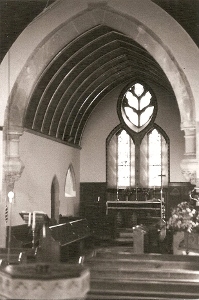Forestside – Christchurch
The mediaeval parish of Stoughton extended to the boundary with Hampshire. It included Stansted Park and the hamlet of Forestside, where Charles Dixon of Stansted built a chapel (VCH 4 p125-26), which was started in 1852, the date on the foundation stone. Consecrated in 1856, this later became the church of a parish, which included Stansted chapel and part of Up Marden. The flint-built church and former school, now in private ownership, are adjacent and were intended to form an entity.
The east end faces the road, with two ogee-headed lancets below a traceried mandorla. Though simple, it is effective with elegantly curved tracery like the veins of a leaf. On the east gable of the nave is a heavy triangular belfry and the side-windows of the chancel are in the form of trefoils. The windows in the nave are grouped trefoil-headed lights, in threes and fours. This is an unusual feature for the date, though found frequently in the later C19. The aisleless interior is dominated by the chancel arch, with dumpy shafts on head-corbels, whose flowing hair turns to foliage. East of the arch, the closely set chancel roof-timbers echo its curves. The splays of the east windows are decorated in dark blue and gold. Though the rest of the walls are plain white, this may not have been so originally.
It would be interesting to identify the architect, for this is a building of quality. On stylistic grounds Ian Nairn proposed S S Teulon (BE p335) and Basil Clarke (Clarke papers) offered the Rev J H Sperling, an amateur architect, who was vicar of nearby Westbourne. The latter, though tempting, can be ruled out as he only arrived in 1862, whilst the attribution to Teulon does not convince; to cite only one reason, the heads on the chancel arch hardly match Teulon’s evangelical sympathies, though he had a liking for good carving. In some respects the parts of the building do not cohere, for example the heavy belfry and the delicate tracery, so it is tempting to follow Clarke’s train of thought and seek another amateur architect, for Sperling was by no means unique, even among the clergy.
Fittings
Font: Shallow and octagonal bowl, profusely carved with foliage and quatrefoils, on a marble stem.
Glass: (East window) As with the church itself, the designer of this vividly coloured glass of 1856 remains unknown. It depicts the Tree of Jesse and is now quite worn.
Seat and desk: (Chancel) H S Goodhart-Rendel, 1926 (BE(W) p626.



